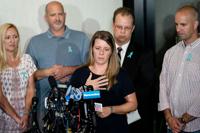(CNN) â� Vernette Kountz had given birth to four children in hospitals â� including a set of surrogate twins â� before deciding she was ready for a different experience.
Kountz said while her previousÌıdeliveries had all been healthy and smooth, she felt her hospital and medical office visits were rushed, routine and impersonal.
âWhen youâre in this medical model, you feel kind of shuffled around, told what to do, you have all of these assessments and ultrasounds,â� Kountz said.ÌıâIt feels more so transactional and less intimate.â�
So, in 2021, when Kountz found out she was pregnant with her fifth child, she decided to have the baby at the Atlanta Birth Center.ÌıThe facility, she said, providedÌıthe holistic, personalÌıand intimate care she had longed for as a motherÌıandÌıshe had a water birth to deliver her son, Hudson.
Kountz said she valued the experience so much sheâsÌıpreparing to deliver her sixth baby at the same birth center in January.
âItâs more than just treating a mom thatâs pregnant,â� she told CNN during a mid-November appointment at the center. âItâsÌılike there is space for all parts of her. It creates a level of intimacy that youâreÌınot really getting from a traditional medical office.â�
Kountz is among aÌısmall butÌıgrowing number ofÌıwomenÌıof color who are choosing birth centers over traditional medical facilities for prenatal, childbirth and postpartum care.
While the majority of births in the US still happen in a hospital setting, in 2020 nearly 2% of people chose to give birth in a âcommunity birth settingâ� such as a birth center or home birth, according toÌıthe most from the National Partnership for WomenÌı& Families,Ìıa nonprofit that tracked these trends based on birth certificate data.
Between 2019Ìıand 2020, thereÌıwas a 30% increase in Black womenÌıopting to give birth in those settings, and a 26% increase for Native American women, according to the nonprofit.ÌıThe number of Hispanic womenÌıchoosing to give birth in those settings increased by 24% and 18% for WhiteÌıas well as Asian women.
The decision by some families to move awayÌıfromÌıtraditional hospital birth settings comes as the nation battles a maternal health crisis in which Black womenÌıareÌınearly threeÌıtimes more likely to die from pregnancy complications than White women, .
Birth centers are often home-like facilities that offer clients longer appointments and moreÌıfreedom and autonomy in their birth experience. They are designed to care forÌıthoseÌıwith low-risk pregnancies and state regulations prohibit them from performing c-sections, according to the American Association of Birth Centers.
Atlanta Birth Center Executive DirectorÌıTamara Taitt said if aÌıclientÌıhas complications beyond the scope of careâÌısuch as elevated blood pressure, a breeched baby, or if the babyâs weight is smaller than its gestational ageÌıâÌıthey areÌıtransferred to a local hospital.ÌıThe birth center also does not offer epidurals, or medications to induce labor, she added.
Birth centers also generally have risk assessment criteria that helps them to determine whether itâs safe for someone to give birth at their facility or if they need to be transferred to a hospital, Taitt said.
TheÌıpivot toÌıbirth centersÌıalso comes as maternity wards across the nation are closing, with many citing low birth rates and insufficient funds as key reasons for shuttering.
The Centinela Hospital Medical Center in Inglewood, California â� a majority Black and Hispanic cityÌıâ� closed its maternity unit in October. A statement released by the hospital said, âthe demand for maternal health services at Centinela has significantly declined over the last several years, with fewer than two deliveries a day.â�Ìı
LeselieyÌıWelch, co-founder andÌıco-directorÌıof Birth Center Equity, said birth centers are often focused on showing respect, building trust and bonding with families â� somethingÌıwomenÌıof color across the country desire, especially those who haveÌıexperiencedÌıtrauma or racism in health care.
According to aÌıÌıreleased in November by the National Partnership ForÌıWomenÌı& Families,ÌıBlack womenÌıare âtwice as likely as White womenÌıto report that a medical professionalÌıignored them, refused a request for help, or failed toÌırespond to requests for help in a reasonable amount of time
WelchÌısaid she feels the disparity in maternal mortality rates is yet another example of the legacy of systemic racism in America.
âThis whole country has operated in a hierarchy of human value based on race,â� Welch said. âOur hospitals and health systems are no exception. Survival should be the least we expect in birth care. ThatâsÌıthe least we can do for so many families in this country.â�
Fueled by a desire to address those inequalities, Welch said she plans to open Birth Detroit in 2024, the cityâs first free-standing birth center led by Black women.
A more tailored experience
Many birth centers are designed toÌıprovide families with theÌıcomforts of home. The delivery rooms at the Atlanta Birth Center, for example, resemble bedrooms with queen size beds, lamps, paintings on the walls and changing tables for babies.
On a recent Friday, Kountz eased herself into a light blue velvet chair in a dimly lit room across from her midwife, Anjli Hinman.
âHow is your body feeling these days?â� Hinman asked.
Kountz, who was 32 weeksÌıpregnant, cupped the side of her belly and explained to Hinman that today had been a good day â� sheÌıdidnâtÌıhave much pelvic floor dysfunction and she was able to walk up and down the stairs at home without help.
They chatted for 30 minutes about everything from Kountzâ� mental health state and her job as a chiropractor, to her family life, water intake and sleep routines. When they were done, Hinman took Kountzâ� blood pressure and used a fetal Doppler to listen to the babyâs heartbeat.
âI see them moving,â� Hinman said, as she moved her hand around Kountzâ� stomach.
ItâsÌıthese interpersonal moments, Kountz toldÌıCNN, that makeÌıappointments at the Atlanta Birth Center, feel so unique. The staff, she added, is fully invested in her physical, mentalÌıand emotional health.
Joia Crear-Perry,ÌıpresidentÌıand founder of theÌıNational BirthÌıEquityÌıCollaborative,Ìısaid she thinks birth centers are rising in popularity becauseÌıwomenÌıwant to interact with providers who understand their cultural needs.
Crear-PerryÌısaid manyÌıwomenÌıof color also choose to deliver at a birth center to combat the racial bias they say they often experience in traditional health care facilities.
The Breath of My Heart Birthplace has served the Indigenous community of rural northern New Mexico since 2010.ÌıÌıFounderÌıBeata Tsosie-Peña said the facility currently handles about eight childbirths a month, with half of those being Native American families.ÌıÌıAccording to the CDC, âAmerican Indian and Alaska Native womenÌıareÌıÌıto die of pregnancy-related causes than White women.â�
Tsosie-Peña said she opened the center because she feltÌıpeople inÌıthe community needed a place that embraced cultural traditions around childbirth with bilingual staff.
Families who deliver at the center are allowed to have ceremonies around the babyâs birth with music, fire, food, herbal medicines and special clothing.ÌıA lot of these practices, she noted, might be limited inÌıa hospital setting.
âThere are a lot of things that different cultures hold around birthing â� and itâs so special and unique,â� Tsosie-Peña said. âI think it really focuses on the needs of the client.â�
âA life-changing timeâ�
Back in Atlanta, Kountz, said she is looking forward to giving birth in the Atlanta Birth Centerâs âFire Room.âÌıItâsÌıone of three nature-themed birthing rooms at the facility.
The Fire Room boasts an orange and black painting of a tree on the wall, a queen size bed topped with a soft orange and blue comforter, a rocking chair and a canvas that reads, âSome women fear the fire and some women simply become it.â�
âIt accommodates that desire to feel home and safe and grounded and protected,â� Kountz said. âThey have aromatherapy, they have music, tapestries, words of affirmation hung up. They are promoting pain coping skills versus narcotics.â�
Hinman, Kountzâs midwife, said she believes birth centers are part of the solution to the maternal health crisis facing Black womenÌıbecause of theirÌıholistic approach.
Staff members, she said, are closelyÌımonitoringÌıtheir clients even during the postpartum period when many face life-threatening complications and depression.
AccordingÌıto a study published in the journal JBI Evidence Synthesis,ÌıwhileÌınearly halfÌıof maternal deaths occur on the first day of birth; 24% occur between days two and seven; and 25% between days eight and 42.Ìı
Simply checking in with a client, HinmanÌısaid, can save their life.
âIt feels like family,â� Hinman said. âThis is a life-changing time for people.â�
CNNâs Rikki Klaus contributed to this report.
The-CNN-Wire
â� & © 2023 Cable News Network, Inc., a Warner Bros. Discovery Company. All rights reserved.












